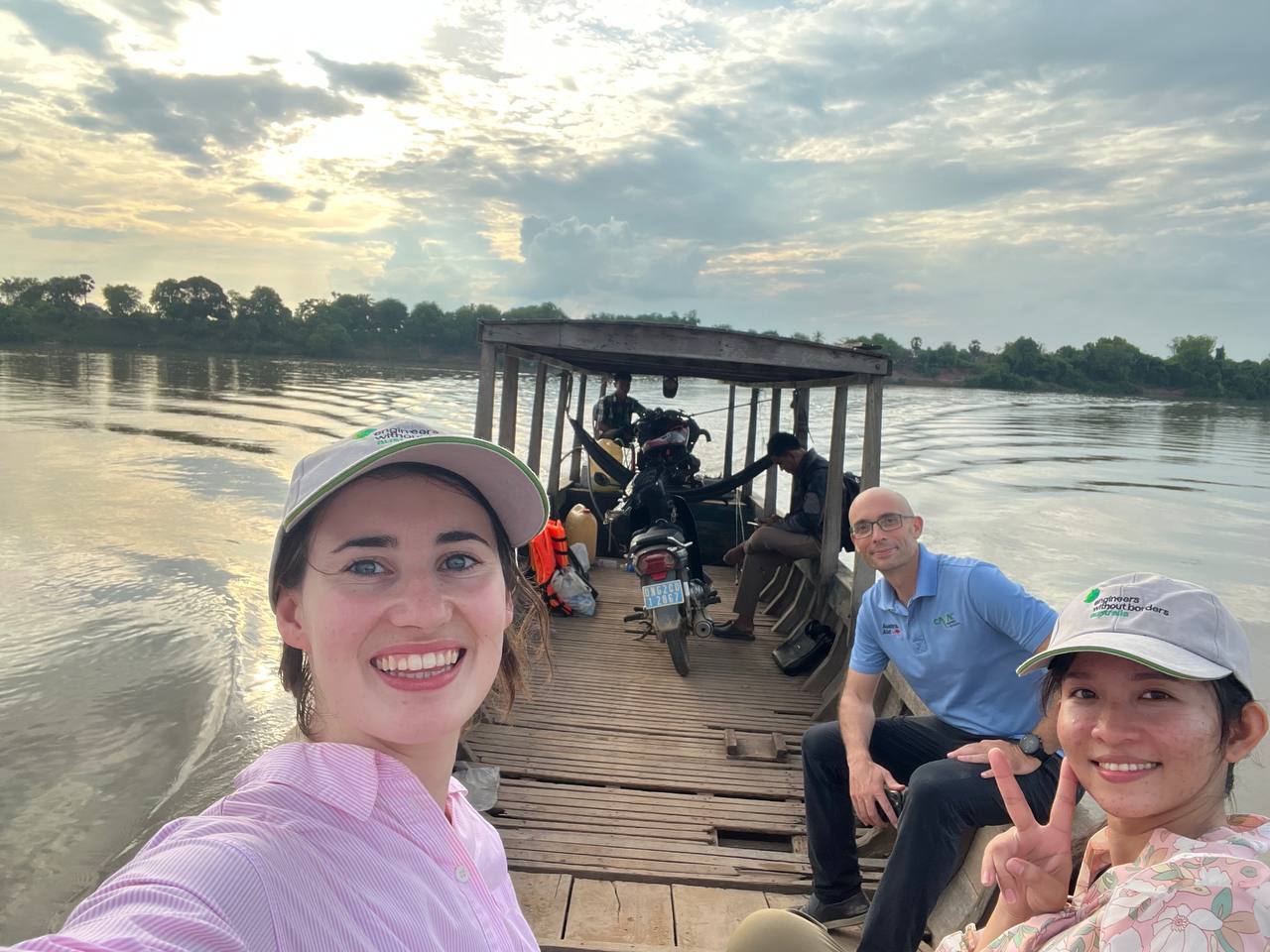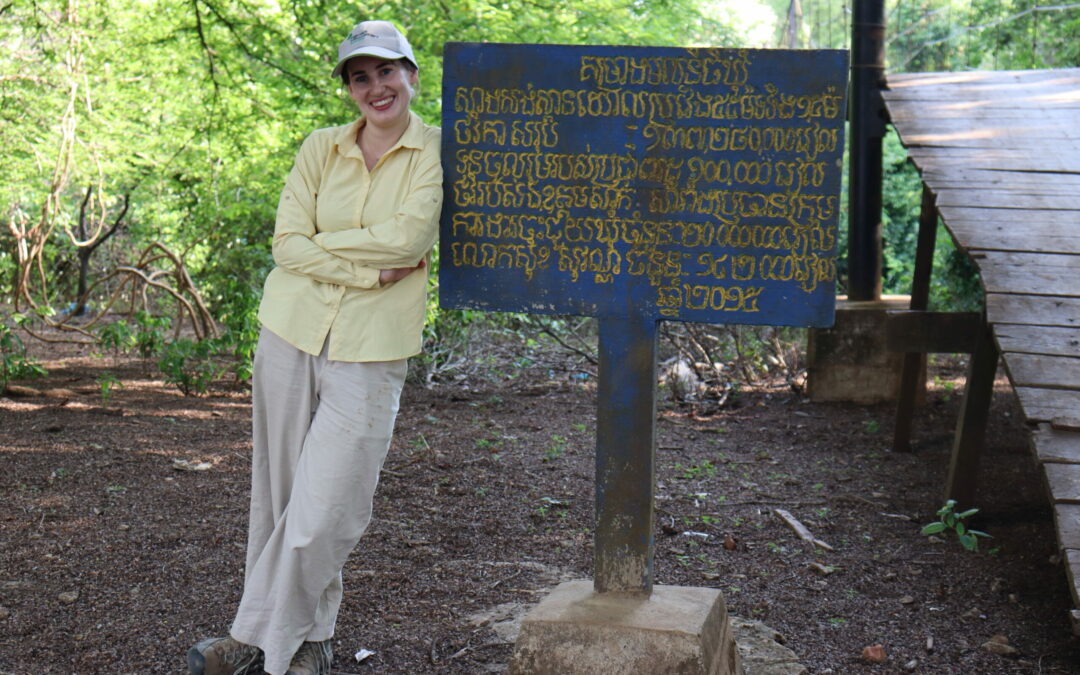Caption: Environmental engineer and EWB Field Professional volunteer, Ella, in Pu Ngaol village.
In 2023, two different community contexts were offered to universities delivering the EWB Challenge Series program. The overseas context looked at the aspirations and challenges of a remote community living in Mondulkiri, Cambodia. EWB Challenge Program Lead, Sai, sat down with EWB Field Professional volunteer, Ella, to hear about her experience holding workshops and interviews with the community at the centre of the Mondulkiri context – Pu Ngaol village.
Picture this; you’re an undergraduate university student working on your first introductory engineering assignment where you are required to draw a bridge for a remote village in Cambodia. Or you are a Master’s student designing a HVAC system for households in Nepal, with variable temperature, pressure, and elevation levels to consider. University teaches you the basics – the software, the calculations, and how to write the report at the end – but how can you be sure that it’s fit for purpose in those locations? Do you really need to understand the socio-technical and cultural aspects of building something for a community you might never visit?
Environmental engineer, Ella, and I recently sat down to discuss that question amidst a million others and spoiler alert – the answer is yes. You do need to understand these aspects of your project work. But who are we to arrive at this conclusion?
My name is Sai and I’m the EWB Challenge Program Lead. I have a Bachelor’s degree in Aerospace Engineering and a Master’s degree in Sustainable Manufacturing Engineering, with experience working in engineering research and development.
Ella recently spent 10 months in Cambodia on an overseas volunteer assignment with the Australian Volunteer Program as EWB’s WASH and Climate Change Technical Mentor. She is an environmental engineer with experience in hydrology, water resource management, and dam engineering. She has a Bachelor of Science majoring in Civil Engineering and a Master’s in Environmental Engineering.

Ella and EWB Technology Development Project Manager, Pin, on a scoping trip in Pu Ngaol village.
Earlier this year, Ella and EWB Technology Development Project Manager Pin Prak visited Pu Ngaol, a rural village in the Mondulkiri province of Cambodia, bordering Vietnam. They conducted participatory design workshops with the community, where they sat down and spoke with residents of the village to understand more about their community practices and the challenges they experience. I was so excited when I heard about this, I had to sit down with Ella to reflect on her experience.
“Mondulkiri is beautiful; rolling hills, very green and cool, quite unlike the rest of lowland Cambodia,” says Ella. Much of Mondulkiri Province is a natural protected area, which is home to wild boars, elephants, birds and snakes.
“But how different is a rural Cambodian village compared to the city’s capital?”
“Very different actually,” Ella tells me. “You move from high rises and concrete to raised wooden houses in small communities.”
“The culture is different, language is different; the magnitude of differences between Khmer and Bunong groups are sometimes as big as the difference between Australian and Cambodian cultures – but other times, they aren’t really that different. You can always find something in common.”
Bunong are an Indigenous minority group in Cambodia and Khmer is the ethnic majority. Most residents living in Pu Ngoal are Bunong and classified as either IDPoor1 or IDPoor 2, with the former being the highest classification of poverty in Cambodia.
”You will never have a complete picture of every aspect of a beneficiary’s need, and it is easy to overlook something critical when seeing a problem from a different lens. Understanding nuances in culture and showing respect to the power of the unknown is something that is not always intuitive as an engineer,” says Ella.
“During one of the workshops, a young mother, said to me, ‘The bore water is contaminated, the river gives us rashes when we swim in it, and that’s where we discard animal carcasses. Where can I find clean water for my baby?’ I had no straight answer for her, it’s not a simple solution, and she knew that.”
Identification of needs and challenges is different across communities and often difficult to ascertain in communities that are geographically and socioeconomically isolated.
High dropout rates of more than 95% in the local school in Pu Ngaol contribute to the challenges in the area. One possible solution the workshop participants came up with was to grow a vegetable garden on the school grounds, where gardening and farming techniques would be taught to students, who could in turn teach their parents.
Problem-solving like this is what engineering boils down to. Community challenges have constraints, variables, and constants. You find a healthy balance between universal requirements and tailor-fitting cultural elements into the solution. It doesn’t matter how you reach the solution.
“We take our socio-technical design units at university for granted, but if we carry these learnings into engineering practice, there is a potential for great lasting impact,” Ella says.
“The learnings are most definitely not a one-off university course. You can really embed it and take it with you in your professional career, not for profit or otherwise.”
As engineers, we tend to focus on our designs, proposals, and reports; but it is important to be open to starting over if the solution doesn’t meet the needs of the community, and take the opportunity to reflect.
“I was an engineer even before I knew what engineering was, it is just who I am, I love problem-solving. I am an engineer by profession but I’m also an engineer in spirit and I always seek to learn about the socio, technical, cultural, and environmental factors of a situation before I think about addressing it” says Ella.
To engineer is human, so why not consider those sociological and environmental factors along your journey?

Ella and EWB Technology Development Specialist, Mariny, accompanying Paul Jenkins from the Australian Embassy in Cambodia on a visit to see EWB projects in Koh Tnaot Island on the Mekong River in Kratie Province.
The EWB Challenge is delivered as part of the EWB Challenge Series, EWB’s real-world curriculum-integrated university education programs. The 2023 EWB Challenge was proudly sponsored by RS Group.
EWB Australia’s international engineering program and volunteer Field Professional placements are generously supported by Australian Volunteers International through the Australian Volunteers Program. Thank you to Ella and all of our wonderful Field Professional volunteers for their contributions to our engineering program.
Interested in volunteering your skills and expertise overseas with EWB? Take a look at our current Field Professional opportunities available here.


